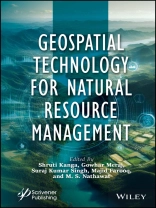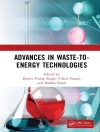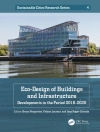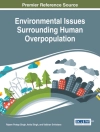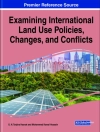This book is essential for anyone interested in understanding and implementing sustainable resource development strategies, as it covers the crucial first stage of assessing resource availability and condition, along with the use of modern geospatial technologies such as remote sensing, GIS, and GPS for surveying, mapping, and monitoring various resources for global environmental protection and sustainable development.
The first step in developing a sustainable resource strategy is assessing the availability and condition of resources. This involves evaluating baseline levels, identifying trends, and understanding their consequences. Mitigation policies are then developed based on this assessment. Modern geospatial technologies like Remote Sensing (RS), Geographic Information Systems (GIS), and Global Positioning Systems (GPS) offer powerful tools for surveying, mapping, and monitoring both renewable and nonrenewable resources. These technologies support global environmental protection, disaster management, and sustainable development by providing repetitive and global data. GPS provides accurate geographic coordinates, while GIS allows visualization, analysis, and decision-making through spatial data, enabling the study of complex environmental and natural resource challenges at various scales.
Table of Content
Preface xix
Acknowledgements xxi
Introduction xxiii
1 Hydro-Chemical Characterization and Geospatial Analysis of Groundwater for Drinking and Agriculture Usage in Bhandara District, Central India 1
Nanabhau Kudnar, Nand Lal Kushwaha, Madiga Rajashekhar, Varun Narayan Mishra, Rongali Mahesh and Malkhan Singh Jatav
1.1 Introduction 2
1.2 Study Area 3
1.3 Methodology 4
1.4 Results and Discussion 10
1.5 Conclusion 20
References 21
2 Technology-Driven Approaches to Enhance Disaster Response and Recovery 25
Chandni Kirpalani
2.1 Introduction 28
2.3 Emergency Communication and Information Management 48
2.4 Geospatial Technologies for Situational Awareness 57
2.5 Data Analytics and Decision Support Systems 66
2.6 Conclusion 74
References 79
3 Integrating Sustainable Development Goals with the Management of Natural and Technological Hazards and Disaster Risk Reduction 83
Prateek Srivastava and Ambrina Sardar Khan
3.1 Introduction 84
3.2 SD and SDGs 92
3.3 Conclusion 128
References 129
4 Hydrological and Morphometric Study of the Girna River Basin, Maharashtra Using Remote Sensing and GIS Techniques 133
Pranaya Diwate, Ashish B Itolikar, Firoz Khan, Kunal Chinche and Pranali Kathe
4.1 Introduction 134
4.2 Study Area 135
4.3 Database and Methodology 136
4.4 Results and Discussion 138
4.5 Conclusion 149
Acknowledgments 150
References 150
5 A Geospatial Analysis of the Effect of Waste Disposal on Groundwater Quality in Ife North Local Government Area, Osun State, Nigeria 153
J. O. Nwaezeigwe and T. A. Babatunde
5.1 Introduction 154
5.2 Study Area 155
5.3 Materials and Methods 156
5.4 Results and Discussion 158
Conclusion 172
References 173
6 Enhancing Sustainable Natural Resource Management Through Innovative Use of Waste Materials in Concrete Production 177
Saurabh Singh, Suraj Kumar Singh, Sujeet Kumar, Bhartendu Sajan and Gowhar Meraj
6.1 Introduction 178
6.2 Data Collection and Methodology 180
6.3 Results and Analysis 183
6.4 Conclusion 186
References 187
7 Dynamics of Land Use/Land Cover of Watershed Changes in Kolhapur District Maharashtra 189
K.S. Kumbhar, Rishikesh Golekar and Pranaya Diwate
7.1 Introduction 190
7.2 Study Area 191
7.3 Methodology 192
7.4 Results and Discussion 193
7.5 Conclusion 203
References 203
8 Formulation and Mapping of GIS-Based Smart Village Plan Using Drone Imagery 207
Suraj Kumar Singh, Shruti Kanga, Sayeed Afridi, Bhartendu Sajan, Saurabh Singh and Gowhar Meraj
8.1 Introduction 208
8.2 Study Area 211
8.3 Materials and Methods 212
8.4 Results and Discussion 220
8.5 Conclusion 234
References 235
9 Varanasi’s Land Mosaic: A Geospatial Analysis for Peri-Urban Area Planning and Management 237
Nitish Kumar Singh, Vijay Kumar Baraik and Mahendra Singh Nathawat
9.1 Introduction 238
9.2 Description of Study Area, Data Source, and Methods 239
9.3 Results and Discussion 243
9.4 Conclusion 254
References 255
10 Human Resource Influences on Online Shopping Behavior: Factors, Preferences, and Satisfaction Among Consumers in North Bengal, India 259
Subham Dey Sarkar, Sushmita Singh, Anuusua Poddar, Tuhin Dey Roy, Pranoy Dey and Arindam Basak
Introduction 260
Influences of Human Resource on Online Shopping Behavior 263
Database and Methodology 263
Factor Analysis 265
Importance-Performance Analysis 266
Result 268
Demographic Profile of Online Shopping Adopters and Non-Adopters 268
Factors of Using Online Shopping 270
Consumer Satisfaction on Online Shopping Attributes 275
Discussion 279
Conclusion 282
References 282
11 Tourism and Protected Areas in India—A Symbiotic Relationship 287
Sagar Sood, Kesar Chand, Aditi Kohli, Shruti Kanga, Suraj Kumar Singh and Gowhar Meraj
Introduction 288
Methodology 289
Conclusion 297
References 297
12 Diatoms from Indian Himalaya (Renuka Lake) Responses to 20th Century Global Warming and Climate Change 303
Pranaya Diwate, Narendra Kumar Meena, Sundeep Pandita, Khayingshing Luirei, Sumedh Humane and Ravi Bhushan
12.1 Introduction 304
12.2 Study Area 306
12.3 Material and Methods 307
12.4 Results 309
12.5 Discussion 314
12.6 Conclusions 317
Acknowledgments 318
References 318
13 Beas Basin Snow Area Health Monitoring Utilizing Remote Sensing with Elevation Zones and Aspect 321
Roy K., Kant C. and Meena R.S.
13.1 Introduction 322
13.2 Materials and Methods 323
13.3 Results and Discussions 329
13.4 Conclusions 337
Acknowledgments 338
References 338
14 Evaluation of Groundwater Potential Zones in Godavari Sub‐Basin Using Analytical Hierarchy Process (AHP) and GIS 343
Manoj Pawar, Pavankumar Giri, Pranali Kathe and Pranaya Diwate
14.1 Introduction 344
14.2 Study Area and Location 345
14.3 Material and Methodology 346
14.4 Results and Discussion 347
14.5 Conclusion 357
References 359
15 Analyzing the Trend of LULC Change Over Five Decades in Dhanbad District, Jharkhand (India) Using Geospatial Techniques 363
Gaurav Chakrabarty, M.S. Nathawat and Suman Sinha
15.1 Introduction 364
15.2 Materials and Methods 367
15.3 Results and Discussion 375
15.4 Limitations and Future Scope 386
15.5 Conclusion 386
Acknowledgments 388
References 388
16 Assessing Land Susceptibility to Degradation and Sustainability Challenges for Siddharthnagar District, Uttar Pradesh 393
Rajesh Kumar Abhay, Shweta Rani and Satish Kumar Saini
16.1 Introduction 394
16.2 Material and Methods 396
16.3 Results and Discussion 399
16.4 Spatial Disparities in Land Susceptibility to Degradation 405
16.5 Conclusion 408
Acknowledgments 409
References 409
17 Examining Socio-Economic Realities and Challenges in West Bengal’s Labor Force: A Case Study 411
Arindam Mondal, Naina Sambher and D.D. Sharma
17.1 Introduction 412
17.2 Review of Literature 413
17.3 Aims and Objectives 415
17.4 Study Area 415
17.5 Data Source and Methodology 416
17.6 Analysis and Discussions 417
17.7 Conclusions 422
Acknowledgments 423
Declaration of Conflicting Interests 423
Funding 423
References 423
18 Reviving the Spiritual Heartland: Enhancing Cultural Tourism in Kushinagar Through SWOT Analysis 425
Ankit Singh and Anjali Shukla
18.1 Introduction 426
18.2 Study Area 427
18.3 Objectives 427
18.4 Methodology 429
18.5 Results and Discussion 430
18.6 Conclusion and Recommendations 442
References 445
Index 449
About the author
Shruti Kanga, Ph D, is an assistant professor in the Centre for Land Resource Management, Central University of Jharkhand, Ranchi. Her main areas of interest include forest fire risk modeling and management, tourism, and resource management. She has attended and organized over 35 national and international conferences. She has over 12 years of teaching and research experience. She was also the course coordinator for different modules of the EDUSAT based distance learning program organized by the Indian Institute of Remote Sensing, ISRO Indian Space Research Organization, Government of India.
Gowhar Meraj, Ph D, works in the field of remote sensing, watershed management, hydrology, disaster risk assessment and mitigation, simulation modelling, and spatial analysis. He is the principal investigator of a Department of Science and Technology, Government of India sponsored research project where he assesses the impact of climate change on the critical ecosystem services of the Kashmir Valley. His work is with INVEST modelling for assessing sediment retention services, water yield services, and habitat quality in the Kashmir valley. He has more than 40 research publications.
Suraj Kumar Singh, Ph D, is an assistant professor at the Centre for Land Resource Management, Central University of Jharkhand, Ranchi. He over 12 years of teaching and research experience in the areas of waterlogging and flood hazards, geospatial applications in water resources, disaster management, hydrogeomorphology, urban planning, and wasteland mapping. He was previously a course coordinator for different modules of the EDUSAT based distance learning program organized by the Indian Institute of Remote Sensing, Indian Space Research Organization, Government of India.
Majid Farooq, Ph D, is a working scientist in the Department of Ecology, Environment and Remote Sensing, Government of Jammu and Kashmir, India. He has more than 15 years of experience in research, teaching, and consultancy related to remote sensing and GIS such as climate change vulnerability assessments, flood modeling, ecosystem assessment, watershed management, natural resource management, ecosystem services, and modeling.
M. S. Nathawat, Ph D, is a scientist of international repute. He has more than 150 publications in various international and national journals. His primary areas of research include remote sensing, natural resource management, environmental assessments, desertification, remote sensing and GIS, natural resources management, physical geography, regional and urban planning, environmental geomorphology, climate change and disaster management. He is also a member of expert committees in various national bodies.
